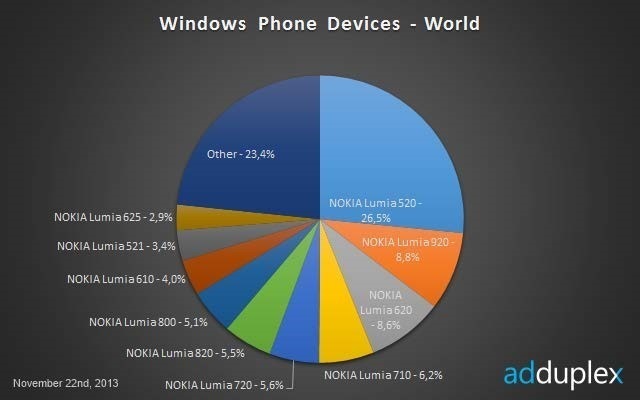Recently, I’ve been reading a lot of upbeat reports regarding Microsoft’s share of the smart phone market. This has been accompanied by claims that Microsoft has finally gotten developers to adopt their Windows Phone 8 platform.
Microsoft’s Windows Phone boss, Joe Belfiore, claims that Microsoft will have completely eliminated its app gap with rival platforms by “the end of 2014.” Writing on his Twitter account, Belfiore has been crowing that “the 3rd ecosystem is decidedly here!”
All well and good. and I congratulate Microsoft on their increased market share. Only here’s the thing…
All Of The Windows Market Share Is Coming From The Bottom Of The Market
Windows Phone’s impressive growth in 2013 has been driven almost entirely by low-end and mid-range smartphones while it’s languished in the high-end market. ((Kantar agrees, stating that a large chunk of Windows Phone sales come from lower-end devices.))
“In Britain, almost three quarters of Nokia Lumia sales in the latest period were low-end devices such as the Lumia 520 and 620 — a pattern that is similar across other EU markets,” said Sunnebo.
Just 1 of the top 4 Windows Phones in the world is a high-end model while the rest of the platform’s top devices are in the low-to-mid-range market.
What’s particularly interesting is that AdDuplex found that the Lumia 1020 — which is not only the best Windows Phone device on the market but has also received a very strong advertising campaign — doesn’t crack the top 10 in any market.
The most popular Windows Phone in the world by far is the Lumia 520, a budget model that accounts for more than one-quarter of all Windows Phone devices sold in the world.
Here is the AdDuplex report showing that the low-end is the driving force behind Windows Phone success:

This is what the Windows Phone device ecosystem looks like over the past 13 months:

If you look carefully at the above chart, it reveals that the low end is growing, the “other” is growing and the high end is being squeezed between them.
The Battle For The Bottom With Android
Android — via Google — isn’t just sitting still and letting Windows regain market share. Google’s recent KitKat OS seems to be designed to run best on low-end devices. Further, Motorola’s Moto G phone may be an attempt to directly attack Microsoft’s new found low-end base.
Biggest Moto G impact could be on Lumia. Great majority of sales are <$200, where quality is better than cheap Android. Not for much longer. ~ Benedict Evans (@BenedictEvans)
It’s difficult to say who will win in the battle for the low end. However, since Microsoft’s ultimate goal is to make money from licensing their software and Google’s goal is to disrupt that business model by giving away their software for free, I believe that Google holds the better cards and — to conflate my metaphors — the upper hand.
Market Share Is Not The Goal
There’s so much talk of market share that we sometimes forget that market share is not the goal. The goal is:
1) To create a viable platform; and
2) Make money.
Taking the bottom of the market will not accomplish either of those goals for Microsoft.
…OEMs are trying to go upstream not downstream. ~ Ben Bajarin (@BenBajarin)
We’ll see. But if Microsoft is going to become a genuine player in phones, it’s going to be a long, long, hard slog. They’ve got the money to stay in the race. But staying in the race is not the same as winning.
Here’s to you, Microsoft. Bottoms up.

And some say you don’t do harder analysis pieces. Bravo, John Kirk! Great piece!
Microsoft is pulling out all the stops on courting developers, however. They aren’t beyond using their substantial bank account to convince developers that Windows Phone is worth some consideration.
I hear there’s exploration of enabling Android applications to run on Windows Phone. The danger there is the same as with OS/2. Why write for Windows Phone when you can cover both by writing for Android?
With Microsoft desperate for any kind of foothold, they may be willing to take such a risk.
“And some say you don’t do harder analysis pieces. Bravo” – Bill Smith
Who says that? I’m not a vindictive man, but I will hunt them down and destroy them!
(Just kidding. I’ll just rough them up a bit.) 🙂
Well, one way or another, I love your analysis work.
For the less talented, like me, well-expressed insight, such as yours, is like 10W40 for the synapses.
“They aren’t beyond using their substantial bank account to convince developers that Windows Phone is worth some consideration.” – Bill Smith
True, but here’s the thing — when are they ever going to make any money?
Microsoft makes money selling licenses. Now they’re selling hardware. Subsidizing the platform to establish it is no way to make money. With Android giving away their OS for free; with Android manufacturers already starting down the price spiral; is there EVER going to be a day when the monies Microsoft has sunk into phones will start to make a profit?
I’m not disputing that even Microsoft’s deep pockets have bottoms (and holes).
The question is whether their pockets are deep enough to get to a tipping point. If, somehow, they can get 5-10 neo-killer, patent-friendly or service-tied apps on their platform, and hold them in exclusive for a year or so…
The problem is that the best applications for a platform are written by people who have bought into that platform’s mindset. What is conceived as a fantastic iOS app will generally be a “nifty” Android or Windows Phone app. For example, Scrivener is amazing on OS X, but nothing special on Windows. Some things don’t translate.
I’d love to see an article on how Java’s fallacy (Write Once; Run Anywhere) has led to a plethora of mediocre-at-best enterprise applications and the dulling of the minds of multiple generations of software engineers.
To get “great” Windows Phone applications, you need developers with that unique creative spark who spend their spare time obsessing about how wonderful Windows Phone would be if… I don’t think you get there with free tools and a $10K prize if your application wins an award.
Ideally, the Windows Phone team should have had a core set of killer apps in mind while they were conceiving the OS.
Let me run with this for a minute… NeXt was conceived around what the Xerox PARC concepts could be. Microsoft Word was conceived based on what the Mac could be. Windows 386 was conceived around trying to be like a Mac running Word. Perhaps there’s a trend here, that the best platforms are conceived around their killer apps, not vice-versa. The Apple folk knew what an iPhone should be able to do, what Deidu and Christensen would call “the job it would be hired to do” before it existed. They roughed out the platform that would bring those killer apps to life…a communicator, a best-in-class Internet device, a phone…and the concepts poured out of that creation into lesser applications and purposes.
Ditto with the iPad, a big touch surface with no interface that would let you manipulate objects with your hands instead of indirection through a mouse and keyboard…drawing with your fingers, manipulating photos, creating music with your hands.
The deeper problem may be this…
Windows had a raison d’être, and the applications for that platform followed. But Windows Phone wasn’t created to perform a job or to enable a solution. Windows Phone and Windows RT were created for an artificial reason…to extend Microsoft’s sphere of influence and, eventually, in hopes of not losing control of the computing marketplace completely. I wonder if Microsoft realizes that they’ve wandered into a space where the motivation has changed?
The origin of Windows and Office is inextricably bound…like Lex Luthor and Superman, Doctor Who and the Daleks. Office was, effectively, created to earn revenue from the Mac platform. Windows was created to be a better, Microsoft-owned platform for Office.
If you aren’t Microsoft, which job does Windows Phone/Windows RT perform? Neither started with a clamor for a home for an application.
Just rambling…
Nice point, mentioning OS/2.
Thanks qka. Let’s just say I’ve been around for a while.
Wouldn’t it be hilarious if Microsoft learned the opposite side of this lesson?
Europe is one of Nokia’s better markets. Apple owns the US and Samsung owns South Korea. With Microsoft now owning Nokia it would not surprise me to see Nokia’s sales in Europe peak in 2013 or even start to slip.
Windows Phone is not growing in Europe. The numbers are false lies. People hate Windows and will not buy it when they have choices. The Windows brand is poison!
Windows phone is an entrant in a market dominated by Android and iPhone. There is no easy success. It makes good sense to focus efforts and attack the market from the low end where iPhone is not present. Although Android Kit-Kat has been designed for lower end devices, it is likely that Windows Phone is still smoother on low spec machines.
Of course Microsoft has a long road ahead of it, but at least the strategy makes sense. They are competing in the low-end market where they can become the leader in smooth UI and general performance, and by virtue of Nokia, in design. Importantly, customers of low-end devices are likely to be less demanding of a wide app selection so that weakness is less damaging. If they can succeed there and gain developer traction, then they can move up-market to the mid-range.
It’s not an easy path, but it’s a path that might work in the end. Personally, I find it a much more viable strategy than the Moto G which is unlikely to change anything without a commitment to build brand awareness and distribution channels worldwide.
Some really excellent info, Sword lily I detected this.
This post post made me think. I will write something about this on my blog. Have a nice day!!